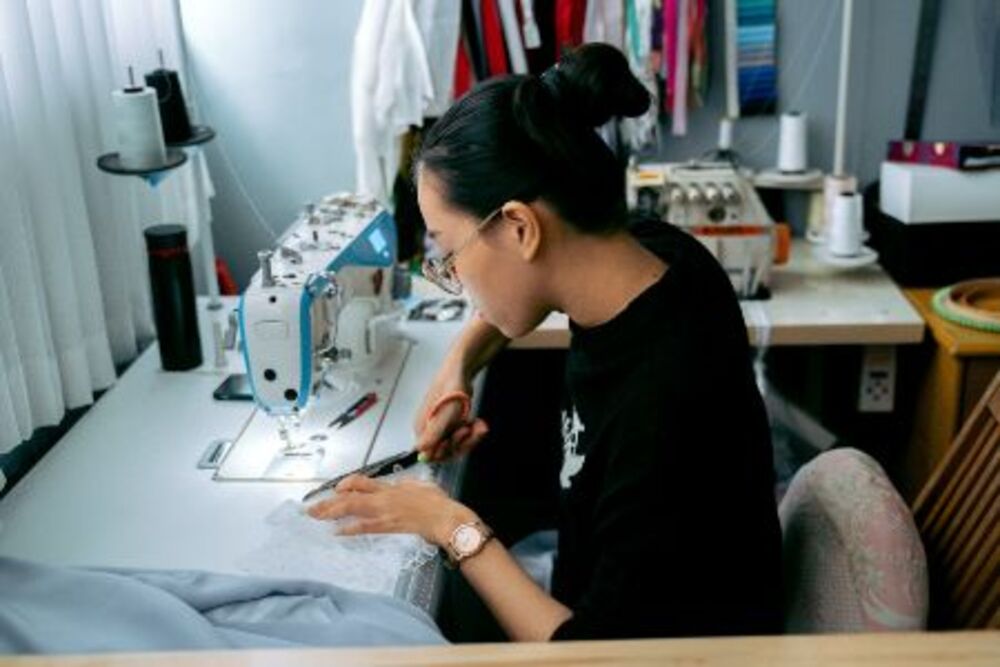The hook that’s in the sewing machine forces the bobbin thread out of its loop, causing the upper and lower threads to interlock in an instant. The needle then goes up the fabric leaving a section of thread on the reverse of the fabric. This basic process works for straight stitches, zigzag stitches, and even fancy stitches like a row of flowers or leaves.
Needle bar
If you’re having trouble with your sewing machine’s needle bar, you should consider making an adjustment. Your needle may not penetrate thin material or make constant tickling noises. You’ll have to check the needle bar and make adjustments, as necessary, before you can begin sewing again.
A mechanism prevents the needle bar from bending is used to control its motion. This mechanism includes a pin that moves in a V-shaped groove. The needle bar then moves vertically while the pin fits in the groove. The needle will stop moving when it reaches the bottom of the V-shaped groove. The hook or shuttle will catch the thread’s loop.
Needle bars are available in different lengths, so it’s important to check the length before you buy. Using a cheap needle bar could cause injury, so it’s important to choose a quality product. You’ll also want to choose a model with a longer stroke, which will allow you to sew thicker fabrics.
The needle bar mechanism in a sewing and embroidery machines for beginners is used to sew leather or cloth. It is a complex mechanism that reduces vibrations and sounds. It works by lowering inertial force on the frame of the sewing machine. This will reduce the chance of the frame breaking or bending and will ensure safety for the user.
Needle clamp
The needle clamp functions of a sewing machine are designed to secure the needle while sewing. The clamp is usually located on the right or the left side of the needle bar and is relatively small. It would increase the weight of the needle bar, and thus increase the energy required to move it. A larger motor is needed. It would also increase the wear and tear on the needle bar’s bearings.
A sewing machine’s needle clamp also allows easy access to the needle. The clamp is a screw that holds the needle in place and helps keep it from moving during stitch formation. It also helps regulate the tension of the needle thread. In addition, a fabric clamp grips the fabric from the feed dog to the top counter, and applies downward pressure on the material as it passes under the needle.
A sewing machine has a tension disc, as well as a screw for the presser foot. These components work together to adjust the tension of the thread, which will affect the stitching of the fabric. While the sewing process is happening, these parts will be pressed and moved around to ensure that the fabric is evenly stitched.
The needle clamp functions of a sewing machine are essential for keeping the fabric in place when sewing. The user can adjust the tension and loosen the needle by using the clamp functions.
Pattern selector
A pattern selector is a mechanical device that allows the user choose from a variety stitch patterns. The pattern selector is a knob mounted on a rotating base that connects to the stitch pattern selector cam mechanism. Once the desired pattern has been selected, a pattern indicator plaque shows it. A feed length indicator plate is also connected to the pattern selector and can be set via a control knob.
The pattern selector is located on the top of the machine and can be adjusted in a variety of settings. One of them controls the amount of pressure on the upper thread. The other setting controls the length and width of the stitches. These buttons can be programmed to adjust the length and width of the stitches in some models.
The feed length indicator mechanism of the sewing machine works as follows: A cam actuating shaft (9) is mounted on the bracket component 2. The shaft is connected with a stepped gearwheel 12 and a feed indicator plate. After the pattern selector knob has been turned, the cam-actuating mechanism will turn the gear wheel 12 to set the machine for that pattern.
Cleaning the pattern selector can prevent it from jamming. Cleaning and oiling your machine may help it turn smoothly. If it is still jammed, it could be due to a problem with the buttonhole adjustment screw.
Feed your dogs
If your feed dogs are stuck in the down position, you may need to adjust the feed lever. After you have adjusted it, you can lower your feed dogs once more. Two types of feed dogs are common for sewing machines. Feed dogs can be raised or lowered, and are often made of metal. Because they help to ensure that the fabric passes through the machine smoothly, feed dogs are an essential part of the sewing process. You may not even realize that you need to adjust them to fit your needs.
There are several ways to clean the feed dogs, including canned air. This is a great way to clean small parts and difficult-to-reach places. However, remember not to clean the feed dogs with a rag as this will push them out of place. You may need to call a technician if the feed dogs become blocked.
If you are unsure if your feed dogs have become clogged or if they are using a different fabric, make sure you have lubricated them. Also, if your feed dogs don’t move properly, you should check the mechanism. Lubricating the hinge points may help. After doing this, remove the needleplate and clean the lint out of between the teeth on the feed dogs. Then, turn the handwheel to engage the feeddogs again.
Tension discs
Tension discs in your sewing machine ensure consistent thread feeding through the needle. Electronics control the discs, which are usually hidden. When threading your sewing machine, be sure to raise the presser foot. This is a good opportunity to adjust the tension of your bobbin or upper thread to ensure equal threading on both sides.
You may need to floss your machine if you have problems with thread tension. You can use floss material or string to go between the discs and keep the thread in place. Make sure to clean the inside of the machine as well. The lint that accumulates on the inside of the machine can interfere with the tension.
If you are having trouble threading your machine, you may have a loose thread that gets stuck in the discs. To help draw the bobbin thread back into the fabric, you can tighten the tension at the top. To prevent dust buildup, it is important to clean the tension disks regularly.
In addition to a dirty machine lint and thread can get stuck between the discs, the bobbin case, and the discs. This will stop the thread from flowing correctly. Moreover, threads and lint may also get lodged between the discs and the throat plate.
Power switch
A power switch on a sewing machine turns the machine on and off. The light switch can also be found near the power switch. The foot pedal controls the sewing speed. The foot pedal controls the sewing speed. Press down on it to start the process. Pushing up on it will stop it. The spoolpin is a spindle made of plastic that holds the sewing thread.
The power switch is usually located on the right side or the sewing machine. The machine will light up when the power switch is turned on. The machine will be illuminated while you are sewing. If the light doesn’t turn on, it may be time to replace the switch.
The machine houses the bobbin. The spool holder, located near the needle, holds the bobbin as it winds. The bobbin winder maintains tension on the thread as it winds. The feed dog holds your fabric while you sew. A feed dog control knob lowers and raises it. You can control the speed of your machine using the foot control or the wheel. You can also use a reverse control lever to sew backwards.
The power switch on a sewing machine is located near the power cord. The power switch is usually located on the right side of the machine. There are also buttons for adjusting the needle and the stitch length. Once you have chosen your settings, you can start sewing. Next, prepare your sewing area. Ensure that you have a comfortable place to sit. You should have good lighting in your sewing area. Lastly, you’ll need to prepare a sewing table where you can safely place your machine.

